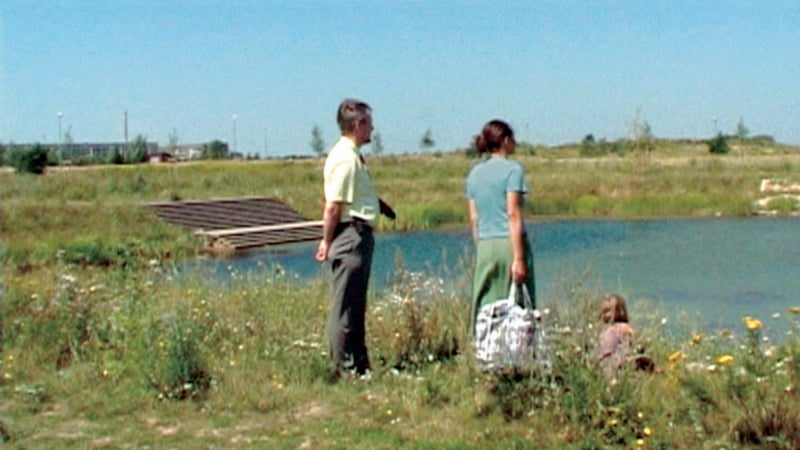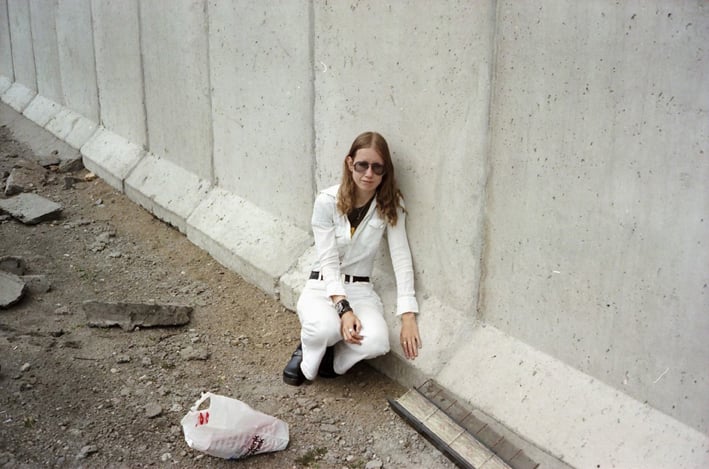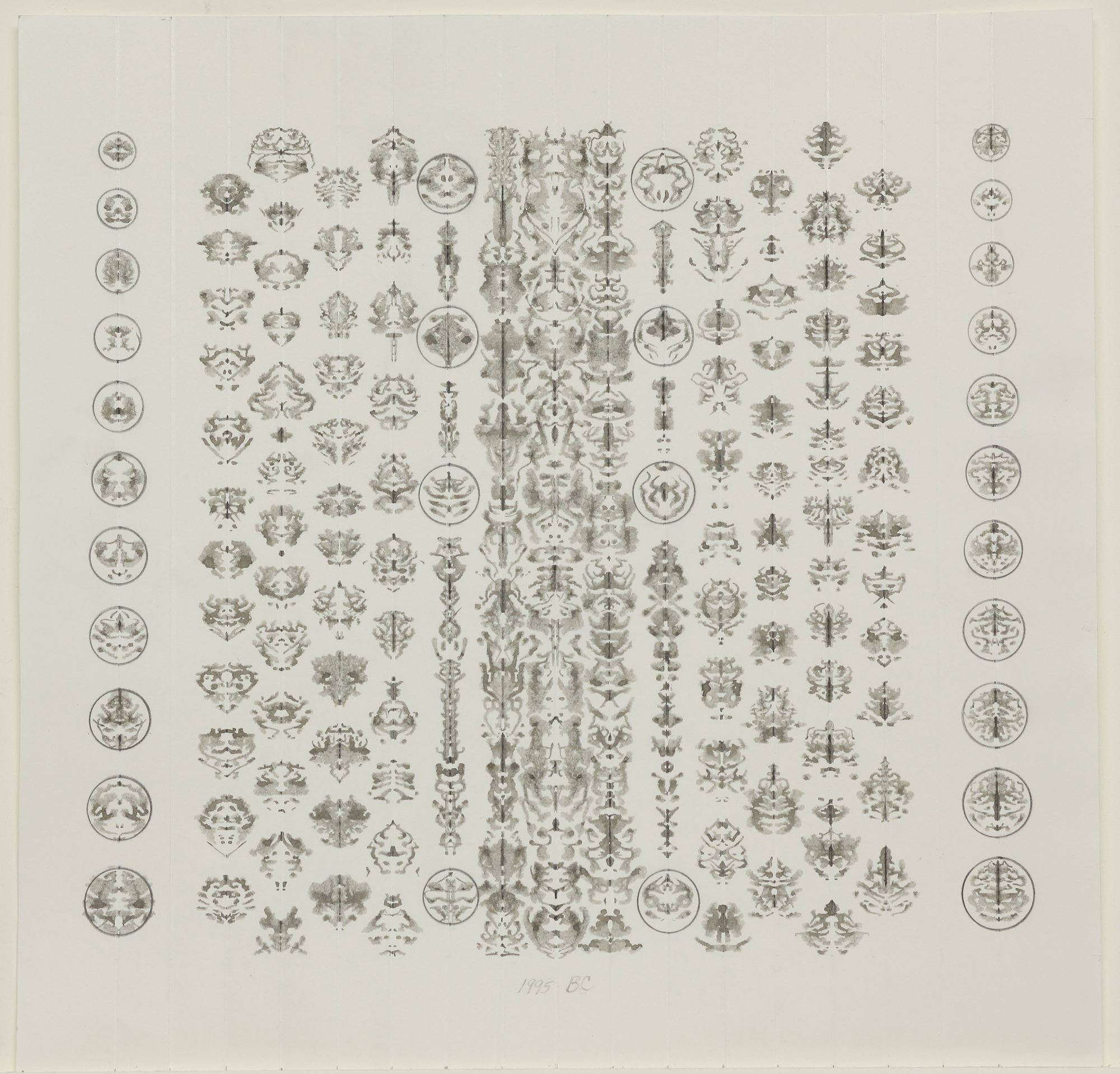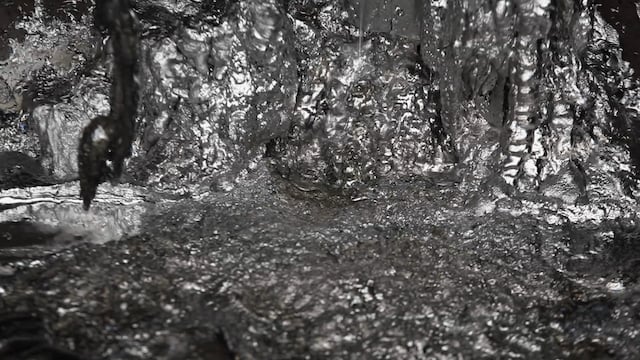
© » KADIST
Guy Woueté
The video installation Le Fou Postcolonial Insane by Guy Woueté is a series of five videos that examine the concept of insanity in the post-colonial Democratic Republic of Congo. The first three videos in the series were shot in a market place in Lubumbashi, the second largest city in the Congo, where several psychoanalysts explore mental health in the context of the Congolese public sphere. Throughout the video series, Woueté links this public health examination to memories of colonial history.

© » KADIST
Clarisse Hahn
Les princes de la rue by Clarisse Hahn is part of Boyzone , a long term project in which the artist observes how men’s bodies reflect their relationships to public and private spaces. Hahn’s photographs move beyond gazing at the Other; they demonstrate how outcast, among themselves, can reproduce the gaze that is cast on them as a means of expression. As such, this series makes space for Hahn’s subjects to intimately express their strength, fragility, and pain, as well as their history.

© » KADIST
María Isabel Rueda
The Real. Retrato de Norman Mejía. (The Real. A Portrait of Norman Mejía.)

© » KADIST
Carlos Motta
Searching for We’wha is composed of five photographic triptychs combining photographs from the American West (New Mexico and Arizona) with excerpts from American Indian poetry in an attempt to reconstruct imaginary aspects of the life of We’Wha, a famous member of the Zuni tribe, who was born male but who lived a feminine gender expression. With this work, Carlos Motta aims to question gender fluidity, indeterminacy, neutrality and non-conformity, using We’wha as an image of the ways in which Two-Spirit American Indians express gender in non-Western non-traditional ways. They are often accepted and revered by their tribes, and in We’wha’s case she even became an official representative of their social interests.

© » KADIST
Robert Zhao Renhui
Expedition #46 is a work from the series “The Glacier Study Group,” which consists of artists, scientists, activists, and enthusiasts of glacial and polar activity in the Artic Circle to conduct scientific investigation, data collection, and glacier sampling. Recent media attention on global warming and climate change has driven interest in increased glacial activity. The group spends long period of each year in the harsh Arctic environment to acquire in-depth knowledge of these changes while experiencing the landscape firsthand.

© » KADIST
Sabelo Mlangeni
The Royal House of Allure is a name of a safe house on mainland Lagos where members of the queer community in need of boarding, due to various circumstances, live together. These houses are more than just places of survival; they are a physical embodiment of radical queer expression that encourage solidarity. The Royal House of Allure was initially conceived following an investigation of how social media influences celebrity culture.

© » KADIST
Li Xiaofei
Combined into a single two-channel HD video, Li Xiaofei’s Ponytail and Chongming Island II are silent portraits of the women assembly line workers at a Chinese kitchenware factory. Close-up shots of women’s heads—most notably of the rear with their hair in the similar updo fashion—and faces occupy the frame amidst a backdrop of a revolving steel conveyor. In lieu of dialogue or humming of the machinery, a ringing score of chimes and bells provides a tranquil soundtrack.

© » KADIST
Hikaru Fujii
Les nucléaires et les choses by Hikaru Fujii is the first video produced in the artist’s long-term project focusing on the Futaba Town Museum of History and Folklore, located in the “difficult-to-return zone” since the Fukushima Daiichi nuclear accident in 2011. Over four years, Fujii filmed the rescue and displacement of this museum’s collection of archeological, historical, or cultural artifacts outside the zone, in order to avoid radioactive contamination and biological damage. He followed the actions, gestures, and reflections of the Futaba Museum curator Takamitsu Yoshino and his collaborators, charged with the preservation of these objects and the knowledge they contain about the territory they come from and the life of its community, struck by the disaster.

© » KADIST
Manuel Correa
La Forma del Presente (The Shape of Now) by Manuel Correa follows a group of survivors of Colombia’s 50-year long armed conflict facing the impossible task of agreeing on a shared past. After half a century of carnage, Colombia achieved peace. Despite an agreement between the government and the Revolutionary armed forces of Colombia (FARC_EP) being rejected by popular vote, the government chose to implement the agreements regardless, further polarizing the public opinion.

© » KADIST
Hikaru Fujii
COVID-19 May 2020 by Hikaru Fujii was filmed during the first months of the Covid-19 pandemic. For this work Fujii filmed the group exhibition Things Entangling, the final phase of a collaboration between KADIST and the Museum of Contemporary Art, Tokyo. At the time that the first Covid-19 lockdowns were instated in Japan, the exhibition was fully installed, but it was not accessible to the public for an indeterminate duration.

© » KADIST
Pablo Pijnappel
In Felicitas, we follow the converging routes of three characters: Felicitas, Michael and Andrew (the artist’s father-in-law who also features elsewhere). Felicitas is thedaughter of a German industrialist who immigrated to Rio after the Second World War. She is the one visible with a toucan in several images.

© » KADIST
Clemens von Wedemeyer
Die Siedlung is a filmic documentary about the recent shift in housing developments in Leipzig-Grünau in former East Germany and its consequences on some inhabitants. It complements von Wedemeyer slightly earlier and more artistic film Silberhöhe (2003) which decried imposed Modernist living model. In Die Siedlung , a voiceover describes and criticizes the different sites on view while the camera moves slowly past a vast abandoned 1930s Nazi army barracks which has yet to be converted or demolished, the building site and wastelands for the new private single family housing area, a constructed pond and finally the 1960s or 70s communal blocks of flats.

© » KADIST
Sabelo Mlangeni
The Royal House of Allure is a name of a safe house on mainland Lagos where members of the queer community in need of boarding, due to various circumstances, live together. These houses are more than just places of survival; they are a physical embodiment of radical queer expression that encourage solidarity. The Royal House of Allure was initially conceived following an investigation of how social media influences celebrity culture.

© » KADIST
Sabelo Mlangeni
The Royal House of Allure is a name of a safe house on mainland Lagos where members of the queer community in need of boarding, due to various circumstances, live together. These houses are more than just places of survival; they are a physical embodiment of radical queer expression that encourage solidarity. The Royal House of Allure was initially conceived following an investigation of how social media influences celebrity culture.

© » KADIST
Sabelo Mlangeni
The Royal House of Allure is a name of a safe house on mainland Lagos where members of the queer community in need of boarding, due to various circumstances, live together. These houses are more than just places of survival; they are a physical embodiment of radical queer expression that encourage solidarity. The Royal House of Allure was initially conceived following an investigation of how social media influences celebrity culture.

© » KADIST
Sabelo Mlangeni
The Royal House of Allure is a name of a safe house on mainland Lagos where members of the queer community in need of boarding, due to various circumstances, live together. These houses are more than just places of survival; they are a physical embodiment of radical queer expression that encourage solidarity. The Royal House of Allure was initially conceived following an investigation of how social media influences celebrity culture.

© » KADIST
Mikhael Subotzky
“Pasvang, Pollsmoor Maximum Security Prison” is the result of three months Subotzky spent inside the walls of Pollsmoor Prison, an overcrowded correctional facility largely controlled by gangs. Through talking to the prisoners and the warders, teaching classes in photography to the inmates and documenting his experiences, Subotzky captured a unique perspective of the prisoners and the prison itself. Subotzky was working digitally, and a key feature of the Pollsmoor work was panoramic images in which he would stitch together a number of shots to give a 360-degree view of the jammed prison wards and spaces.

© » KADIST
Sabelo Mlangeni
The Royal House of Allure is a name of a safe house on mainland Lagos where members of the queer community in need of boarding, due to various circumstances, live together. These houses are more than just places of survival; they are a physical embodiment of radical queer expression that encourage solidarity. The Royal House of Allure was initially conceived following an investigation of how social media influences celebrity culture.

© » KADIST
Sabelo Mlangeni
The Royal House of Allure is a name of a safe house on mainland Lagos where members of the queer community in need of boarding, due to various circumstances, live together. These houses are more than just places of survival; they are a physical embodiment of radical queer expression that encourage solidarity. The Royal House of Allure was initially conceived following an investigation of how social media influences celebrity culture.

© » KADIST
Lars Laumann
Eija Riitta was born in 1954 in Liden, Sweden, and is “objectum-sexual.” Since June 17, 1979, her name is Eija Riitta Berliner Mauer taking the name of her husband, the Berlin Wall. In animism all elements of nature are considered as alive and have souls. “Objectum-sexuality” is an extension of this belief.

© » KADIST
Olive Martin and Patrick Bernier
The Mohawk, the emblematic Frontier river in the period of American colonisation, is here a cable of data transmission, and the 7 Sultans Casino is a virtual destination, one of the three hundred online casinos hosted by the servers located in Kahnawake, a small native american indian reserve to the south of Montreal. Incorporating poker, challenges to the law, a struggle for the control of a new territory where the stakes are high, our film ‘La Nouvelle Kahnawake’, between fiction and documentary, pushes these analogies with the Western to explore both our relationship to the figure of the ‘Indian’ and the confusion of our perception of space that new information technology has brought about. As the artists state: “We are neither anthropologists nor journalists.

© » KADIST
Hwayeon Nam
Imjingawa is Hwayeon Nam’s first foray into borrowing from the documentary form. The root of the work is a Japanese song with Korean diasporic connotations, which the artist heard inadvertently years ago. While tracking the inception and history of the song, her research explored the song’s potential to live beyond “legal, national, ideological, and geographical barriers.” The song earned its fame when it was introduced to the Japanese band, the Folk Crusaders.

© » KADIST
James T. Hong
Lessons of the Blood by James T. Hong pieces together interviews, extensive archival and field research, and TV footage addressing Japan’s use of biological warfare and experimentation on Chinese prisoners during World War II, as well as the revisionism of the Japanese government and Chinese survivors’ attempts to live with this horrific history and to find justice. Co-written, directed, edited and produced with Yin-Ju Chen, whose work is also represented in the Kadist collection, Lessons of the Blood is a meditation on propaganda, the ways in which national mythologies can literally infect and poison the most vulnerable among us, and the legacy of World War II in China, presented through the testimonies of survivors, academics, medical experts, nationalists and activists. The film locates its genesis in the publication of the New History Textbook in Japan in 2000, which infamously glossed over the Japanese Empire’s wartime atrocities, sparking rage and violent protests in China and South Korea in 2005.

© » KADIST
Pavel Wolberg
A young settler girl, dressed in a bridal outfit for Purim, stands in a street in Hebron waiting, perhaps for her parents or other children to join her. In the background three soldiers scan the buildings and the rooftops for threatening presences. Turning her back to the soldiers, the little girl pays no attention to what surrounds her.

© » KADIST
Alex Lukas
Three hours west of New York City is the town of Centralia, Pennsylvania. The story of this eastern ghost town’s demise has become legend: in 1962 burning trash ignited a vein of anthracite coal, starting an underground fire that continues to burn today, forcing the town’s depopulation. Centralia has since become a pilgrimage site; or rather a mile-long stretch of state route 61 outside of the town that sits abandoned, its surface buckled and cracked by the underground fire.

© » KADIST
J. John Priola
Priola pays particular attention to otherwise unnoticed details in the cityscape, a quality that not only recurs throughout his oeuvre, but which also places his work in line with a strong tradition of California documentary photography. Close-ups and attention to detail reveal something different: a portrait of what is usually discarded or missing, like unassuming weep holes in Alameda Street or minuscule weeds making their way up through the pavement in Chestnut Street . But these details are subtle to the point of being conceptual; from afar both images appear to be monochromes.

© » KADIST
David Goldblatt
David Goldblatt’s “Boksburg series” is a telling portrait of the small town that became a notorious symbol of racism in South Africa. The photographic essay negotiates the troublesome landscape of the apartheid through capturing the intimate in-between moments that are seemingly inconsequential and visually inoffensive. However, it is in this series that Goldblatt provides a candid insight into the white communities during the apartheid.

© » KADIST
CAMP
The Annotated “Gujarat and the Sea” Exhibition is a collateral project within the larger body of work around the Indian Ocean, entitled “Wharfage” (2009-13) which has included over the years a radio event, several books and a film. “Boat Modes” (2009-12) dealt with the modalities of maritime life on ships and in ports between UAE, Southern Iran, India and Somalia, using photographs, texts and film based on mobile phone videos made by sailors. CAMP sees this work as a kind of historical intervention on the same subject.

© » KADIST
Li Ran
In his video work Beyond Geography , Li dramatizes the role of the artist-as-imitator to the point of sheer parody. Dressed to toe in the costume of a typical Discovery Channel adventurer-explorer, the artist dashes suavely through the uncharted jungle habitat of a primitive tribe. Li modulates his own voice in laughably accurate mimicry of the dubbed Discovery Channel protagonist familiar to Chinese viewership, daringly gulping fresh water from a river, expertly admiring exotic vegetation, and whimpering in fear of the dark sounds of the night (screaming, even, as he trips on a human skull) in an full-scale exaggeration of a nature show personality.

© » KADIST
Bruce Conner
In 1977, as an already-established artist best known for his films, Bruce Conner began to photograph punk rock shows at Mabuhay Gardens, a San Francisco club and music venue. 27 Punk Photos: 11. Dim Wanker: F Word, May, 1978 (1978) is representative of a series of photographs by Conner, whose subject became a fascination for the artist.
Sabelo Mlangeni
Photographer Sabelo Mlangeni’s black and white images capture the intimate, everyday moments of communities in contemporary South Africa...
Hikaru Fujii
Hikaru Fujii utilizes film to bridge art and social activism...
Clemens von Wedemeyer
- location: Göttingen, Deutschland
- year born: 1974
- gender: male
- nationality: German
Alex Lukas
Alex Lukas’s practice is much akin to that of the researcher, historian or collector of folklore, exploring exceptional sites in the American landscape...
David Goldblatt
- location: Randfontein, South Africa
- year born: 1930
- gender: male
- nationality: South African
Robert Zhao Renhui
Robert Zhao Renhui’s multimedia practice questions fact-based presentations of ecological conservation and reveals the manner in which documentary, journalistic, and scientific reports sensationalize nature in order to elicit viewer sympathy...
Hwayeon Nam
Hwayeon Nam’s practice employs an artistic language that vigorously investigates the movement and phenomenon of various objects operating in sync with social systems, as well as the structure and nature of time...
Carlos Motta
Carlos Motta’s is a multi-disciplinary artist whose work seeks to document the social conditions and political struggles of sexual, gender, and ethnic minority communities through a variety of variety of mediums including video, installation, sculpture, drawing, web-based projects, performance, and symposia...
Bruce Conner
- location: San Francisco, California
- year born: 1933
- gender: male
- nationality: American
- home town: McPherson, Kansas
Pavel Wolberg
Pavel Wolberg studied photography at the Camera Obscura School of Art in Tel Aviv...
Mikhael Subotzky
Mikhael Subotzky’s (b...
Li Xiaofei
Li Xiaofei initiated Assembly Line in 2010, an ongoing project that records industrialized social change not only China, but as it occurs internationally...
Manuel Correa
Manuel Correa’s practice deals with the reconstruction of post-conflict intergenerational memory in contemporary societies...
Clarisse Hahn
Through her films, photographs and video installations, Clarisse Hahn continues a documentary research on communities, behavioral codes and the social role of the body...
Li Ran
- location: Beijing, China
- year born: 1986
- gender: male
- nationality: Chinese
- home town: Hubei Province, China
Olive Martin and Patrick Bernier
Patrick Bernier and Olive Martin are a duo of artists collaborating since 1999...
James T. Hong
James T...
CAMP
CAMP is an artistic collective that started working as a group in 2007, initially consisting of Shaina Anand (filmmaker and artist), Sanjay Bhangar (software programmer) and Ashok Sukumaran (architect and artist)...
J. John Priola
In his characteristic black-and-white gelatin silver prints, San Franicisco-based J...
Pablo Pijnappel
Pablo Pijnappel’s work is foremost highly constructed...
-
1970-1979
Bruce Conner
1978In 1977, as an already-established artist best known for his films, Bruce Conner began to photograph punk rock shows at Mabuhay Gardens, a San Francisco club and music venue...
David Goldblatt
1979David Goldblatt’s “Boksburg series” is a telling portrait of the small town that became a notorious symbol of racism in South Africa...
-
2000-2009
Mikhael Subotzky
2004“Pasvang, Pollsmoor Maximum Security Prison” is the result of three months Subotzky spent inside the walls of Pollsmoor Prison, an overcrowded correctional facility largely controlled by gangs...
Clemens von Wedemeyer
2004Die Siedlung is a filmic documentary about the recent shift in housing developments in Leipzig-Grünau in former East Germany and its consequences on some inhabitants...
Pavel Wolberg
2004A young settler girl, dressed in a bridal outfit for Purim, stands in a street in Hebron waiting, perhaps for her parents or other children to join her...
Pablo Pijnappel
2005In Felicitas, we follow the converging routes of three characters: Felicitas, Michael and Andrew (the artist’s father-in-law who also features elsewhere)...
Lars Laumann
2008Eija Riitta was born in 1954 in Liden, Sweden, and is “objectum-sexual.” Since June 17, 1979, her name is Eija Riitta Berliner Mauer taking the name of her husband, the Berlin Wall...
J. John Priola
2008Priola pays particular attention to otherwise unnoticed details in the cityscape, a quality that not only recurs throughout his oeuvre, but which also places his work in line with a strong tradition of California documentary photography...
-
2010-2019
Olive Martin and Patrick Bernier
2010The Mohawk, the emblematic Frontier river in the period of American colonisation, is here a cable of data transmission, and the 7 Sultans Casino is a virtual destination, one of the three hundred online casinos hosted by the servers located in Kahnawake, a small native american indian reserve to the south of Montreal...
Robert Zhao Renhui
2012Expedition #46 is a work from the series “The Glacier Study Group,” which consists of artists, scientists, activists, and enthusiasts of glacial and polar activity in the Artic Circle to conduct scientific investigation, data collection, and glacier sampling...
Carlos Motta
2014Searching for We’wha is composed of five photographic triptychs combining photographs from the American West (New Mexico and Arizona) with excerpts from American Indian poetry in an attempt to reconstruct imaginary aspects of the life of We’Wha, a famous member of the Zuni tribe, who was born male but who lived a feminine gender expression...
Manuel Correa
2018La Forma del Presente (The Shape of Now) by Manuel Correa follows a group of survivors of Colombia’s 50-year long armed conflict facing the impossible task of agreeing on a shared past...
Hikaru Fujii
2019Les nucléaires et les choses by Hikaru Fujii is the first video produced in the artist’s long-term project focusing on the Futaba Town Museum of History and Folklore, located in the “difficult-to-return zone” since the Fukushima Daiichi nuclear accident in 2011...
Guy Woueté
2019The video installation Le Fou Postcolonial Insane by Guy Woueté is a series of five videos that examine the concept of insanity in the post-colonial Democratic Republic of Congo...
Sabelo Mlangeni
2019The Royal House of Allure is a name of a safe house on mainland Lagos where members of the queer community in need of boarding, due to various circumstances, live together...
Sabelo Mlangeni
2019The Royal House of Allure is a name of a safe house on mainland Lagos where members of the queer community in need of boarding, due to various circumstances, live together...
Sabelo Mlangeni
2019The Royal House of Allure is a name of a safe house on mainland Lagos where members of the queer community in need of boarding, due to various circumstances, live together...
Sabelo Mlangeni
2019The Royal House of Allure is a name of a safe house on mainland Lagos where members of the queer community in need of boarding, due to various circumstances, live together...
Sabelo Mlangeni
2019The Royal House of Allure is a name of a safe house on mainland Lagos where members of the queer community in need of boarding, due to various circumstances, live together...
Sabelo Mlangeni
2019The Royal House of Allure is a name of a safe house on mainland Lagos where members of the queer community in need of boarding, due to various circumstances, live together...
Sabelo Mlangeni
2019The Royal House of Allure is a name of a safe house on mainland Lagos where members of the queer community in need of boarding, due to various circumstances, live together...
-
2020-2029
Hikaru Fujii
2020COVID-19 May 2020 by Hikaru Fujii was filmed during the first months of the Covid-19 pandemic...
Clarisse Hahn
2020Les princes de la rue by Clarisse Hahn is part of Boyzone , a long term project in which the artist observes how men’s bodies reflect their relationships to public and private spaces...










